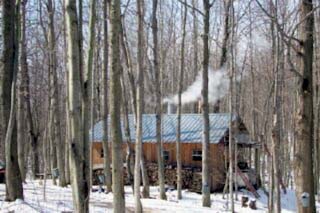
Because of the frigid temperatures, the region expects the tapping of maple trees (sugar, black and some red) for maple syrup production to be delayed by as much as two weeks with tapping to be around March 15. Current weather and environmental conditions are similar to the winter of 2003 when prolonged freezing temperatures delayed the window for tapping trees by as much as 15 days in some areas and in some cases producers were unable to tap at all. The wet summer of 2004 promoted good growth on maple trees but prolonged frigid temperatures have encouraged a delayed window for tapping, which usually runs from the end of February to the end of March in western New York. Bob King from Cornell Cooperative Extension said that in terms of both quantity and quality, the past summer's wet conditions coupled with dry fall weather and an average snow fall has promoted ideal environmental conditions for local syrup production. However, sugar bush operations require above freezing temperatures (32-45) during the day along with freezing temperatures at night which creates a differential in the pressure of the tree to encourage sap flow. Persistent frigid temperatures during January and February have significantly contributed to most maple trees continually being frozen solid while soils have been insulated from freezing temperatures due to moderate snow pack. There was a brief window of ideal temperatures for tapping of some maple trees about three weeks ago, but weather conditions have returned back to freezing temperatures, hence the first sap run was short lived. Operations making syrup during this time reported that most sap yielded medium grade syrup, King said. As the region heads toward spring (March 21), the sun rises higher in the sky which contributes to additional radiant heat as a result of extended and more direct sunshine. This direct sunshine contributes not only to warmer ambient air temperatures but significantly contributes to an increase in surface temperatures of the tree. Consequently, an increase in radiant heat promotes a physiological change in the tree that triggers bud formation resulting in the formation of buddy sap which signifies the end of the tapping season. Buddy sap has a very unpleasant odor and many producers that specialize in only high quality syrup will stop collecting sap. It is the first run of sap which usually produces a highly desirable light and delicate flavored syrup. Sap at the beginning of the season is water white, clear and transparent. It has a sweet taste and practically no odor. Prices paid by consumers are expected to be similar to last year, ranging from $30 to $45 per gallon depending on the grade of syrup. |
